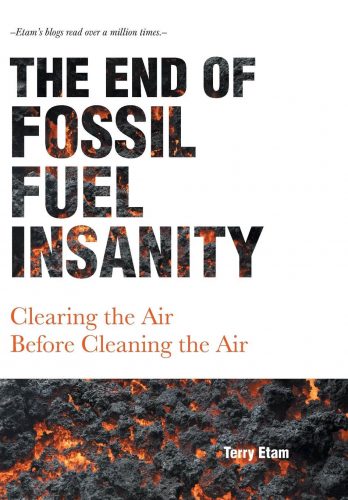Introduction
Today’s column continues with my presentation of the previously announced series of columns, which introduces three publications that, as I indicated earlier, have had a profound impact on both my understanding of, and insights into today’s highly volatile dynamic in unfolding global energy markets. In doing so, today’s column introduces the second of these texts; namely Terry Etam’s, The End to Fossil Fuel Insanity: Clearing the Air Before Cleaning the Air. To recap, last week’s column had introduced the first of the three publications; namely, The United States Energy Information Administration’s Report entitled, International Energy Outlook 2019, with Projections to 2050.
As might be anticipated, the high repute and strong standing of the United States Department of Energy vouch for the requisite quality of all its reports, especially as regard their data selection, rigor of analysis and their professional attention to detail. In regard to Terry Etam, he is a well-reputed and long-standing writer and practitioner in the field of energy. He is also, a co-producer/ contributor for two celebrated online oil publications; namely, the BoE Report and Public Energy Number One. His book has received several accolades, two of which stand out to me. One of these has deemed him a “thought leader” based on his expression of ideas and expertise exhibited in his writings. And, the other accolade claims that his body of work represents “the most influential voice in the oil patch”

These data are reported here, because they help frame the context of my evaluation of the three publications under consideration. In this regard, readers should bear in mind that Guyana’s oil finds, although striking, are yet-to-peak, YTP. This is the lesson, above all others, which I urge serious readers to keep to the forefront constantly.
Terry Etam’s … Propositions
I have taken the great risk of reducing Terry Etam’s rich analysis to four major propositions, which I list in the next paragraph. This has been done for purely pedagogic purposes and is not intended to suggest it is my view that the author would approve, let alone support this effort. I therefore, fully acknowledge the attendant risks of unintended simplification and failure to capture subtleties and nuances intended to be conveyed by the author.
The propositions are listed in the order needed to convey the book’s logical structure:
Proposition 1 – Common acceptance that fossil fuel usage is inherently finite
Proposition 2 – Given 1, change-over from fossil fuel at some point is inevitable
Proposition 3 – Given 2, two forces contend: namely climate change & its linked activism; plus, immense technical challenges to replace oil as supplies dwindle
Proposition 4 – Given 3, Green ideals war with immense huge technical challenges.
Going forward I shall address these propositions in the order listed above.
Proposition 1 Explained
I have described the first proposition as Etam’s broad acceptance of the reality that, a global shift away from fossil fuels is inevitable. Indeed, the finite non-renewable nature of petroleum energy (within geologic time) guarantees this outcome. However, two observations need to be noted. One is that by terming fossil fuels as finite is meant, they are not renewable within even several life times. And the other, is basically that, the proposition as advanced here is entirely independent of any predictive theorizing, like for example, the well-known “Hubbert Curve” This curve seeks to determine when petroleum consumption, or indeed any finite natural resource might peak globally and/or regionally
More formally, according to Investopedia, the Hubbert curve is a graph showing the production rate for any finite natural resource. It resembles a symmetrical bell-shaped curve indicating a peak point, termed Hubbert Peak Oil in the crude oil sector. At this peak global crude oil production reaches its maximum and thereafter production declines. This prediction was made in the early 1970s and projected peak oil to be reached in the late 1990s. Based on poor economic reasoning, this prediction led to the peaking, not of crude oil, but to the surfacing of what I have dismissed elsewhere as “noise and nonsense” in global discussion of crude oil. Indeed, peak oil forecasting became the tool of choice among fake news and disinformation purveyors of doom and gloom.
Nuances
Terry Etam book is nuanced and in interviews and podcasts post publication he has continued to stick to broad formulations like “everyone knows that fossil fuels won’t last forever.” I believe such an approach insulates his work from the often-sterile debates in regard to predicting correctly the end of fossil fuel dominance in global energy consumption. It also allows him to move on swiftly to assert somewhat vaguely that “something needs to change at some point.”
Conclusion
Next week‘s column will conclude my discussion of Terry Etam’s book.






